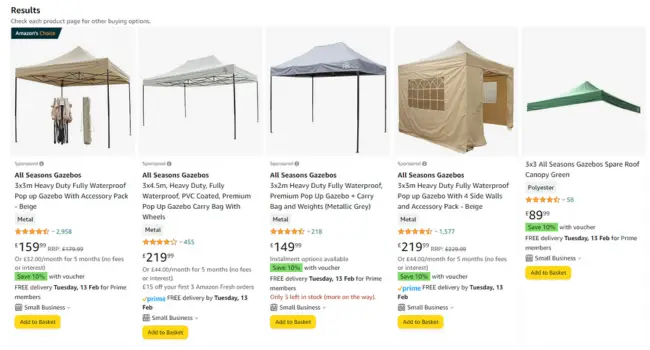There is fierce competition among the thousands of sellers on Amazon for the attention of customers. If you want to stand out, and optimize profitability, it is crucial to carry out in-depth research on your competitors.
In doing so, you’ll gain insight into your competitors’ actions that can help you improve product listings, refine pricing tactics, and uncover growth opportunities.
Why Amazon competitor analysis matters
Amazon’s marketplace is dynamic, with constant changes in pricing strategies, marketing approaches, and customer habits.
A well executed analysis means you can identify top competitors and examine their pricing methods. With this information, you can use competitor analysis to boost conversions by:
- Optimizing product listings for better visibility and conversions
- Understanding competitors’ marketing strategies
- Spotting market gaps to differentiate your offerings
- Enhancing customer engagement through targeted improvements
How to Determine Who Your Amazon Competitors Are
Find out who your actual competitors are before you start your analysis. These typically fall into two camps: indirect competitors and direct competitors.
What’s the difference? While indirect competitors could offer different items but still compete for the same customers, direct competitors provide the same or very similar products.
You can find competitors by:
- Using Amazon Brand Analytics (for Brand Registered Sellers)
- Reviewing sponsored products to see who bids on relevant keywords
- Looking through Amazon’s Best Sellers list for top-ranking products in your niche
- Performing a relevant keyword search for your product and analyzing the top-ranking listings

Key Factors to Analyze in Amazon Seller Competitor Analysis
Find out who your actual competitors are before you start your analysis. These typically fall into two camps: indirect competitors and direct competitors.
What’s the difference? While indirect competitors could offer different items but still compete for the same customers, direct competitors provide the same or very similar products.
You can find competitors by:
- Using Amazon Brand Analytics (for Brand Registered Sellers)
- Reviewing sponsored products to see who bids on relevant keywords
- Looking through Amazon’s Best Sellers list for top-ranking products in your niche
- Performing a relevant keyword search for your product and analyzing the top-ranking listings
Pricing strategy
Pricing is a major factor in attracting buyers and winning the Amazon Buy Box. To analyze competitor pricing patterns, consider:
- Comparing base and reduced prices
- The frequency of price changes
- Differences between FBA and FBM pricing (FBA sellers often charge more due to Prime benefits)
- Usage of subscription offerings like Subscribe & Save or bundles
Tools that track past pricing trends include Keepa and CamelCamelCamel.
Product listings
A well-optimized product listing has a big impact on conversions and exposure. By looking at titles, bullet points, photos, videos, A+ content, and keyword usage, you can compare your listing to that of your top competitors.
Competitors with higher rankings frequently improve their listings with compelling descriptions and excellent images.
Customer reviews and ratings
Customers find reviews and feedback to be a powerful indicator of trust. You can use them to dig deeper into your competitors’ successes and identify opportunities where you can stand out.
Take a close look at average star ratings, common complaints, favorable aspects, and review volume.
Finding patterns in what customers say enables you to fix common issues and improve the products you provide.
Amazon advertising strategy
Gaining knowledge about competitors’ advertising strategies is an effective way to learn about their targeting and marketing budget. Look into:
- How competitors employ PPC campaigns
- What images and language they use
- The keywords they target
- The placement of their ads
These insights can be found with the use of tools such as Nozzle’s competition analysis tool.
Logistics and fulfillment
Conversion rates & customer satisfaction are impacted by fast shipping and reliable fulfillment. Analyze competitors’ delivery times, return policies, stock availability and how they use FBA, FBM, or Seller Fulfilled Prime. These elements affect both brand reputation and consumer purchase decisions.
Making the most of Amazon competitor analysis
Once you’ve gathered insights, the next step is putting them into action strategically. Here are some smart ways to do it:
- Stay competitive with pricing – Adjust your prices dynamically, create attractive bundles, and run limited-time sales strategically to maximize profits.
Enhance your product listings – Optimize your keywords, refine your descriptions, and use high-quality images to make your products stand out.
Build customer trust – Address common complaints found in your own product or similar competitor product reviews. Offer top-notch customer service, and provide guarantees or incentives.
Improve your advertising strategy – Use retargeting ads, focus on high-performing keywords, and target competitor listings to boost visibility.
Streamline fulfillment – Keep inventory in check and offer faster delivery options to improve customer satisfaction.
By implementing these tactics, you can stay ahead of the competition and make the most of your presence on Amazon.
Key takeaways
Keeping an eye on your competitors allows you to make informed adjustments and stay competitive in the Amazon marketplace.
Want to master Amazon marketing? Explore our comprehensive strategy service here. Need personalized support? Contact us for expert assistance.


